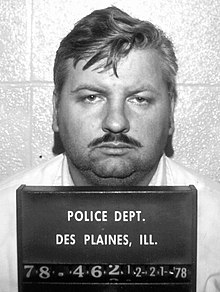John Wayne Gacy, a notorious serial killer who terrorized the community in the 1970s, faced the ultimate punishment for his heinous crimes. We’ll explore what led to his demise and how his cruel acts ultimately determined his own fate.
Gacy’s disturbed and violent past garnered him the infamous nicknames “Pogo the Clown” and “Killer Clown,” as he committed horrendous acts of murder and torture against at least 33 victims. His reign of terror finally ended when he was arrested in 1978, ultimately sealing his own future. Following a lengthy trial and subsequent appeals, Gacy met his end through execution, paying the price for the lives he took and the suffering he caused.
The cause of this brutal serial killer’s death was lethal injection, considered by many to be a fitting end to a life filled with gruesome crimes. On May 10, 1994, Gacy was sent to the execution chamber at Stateville Correctional Center in Illinois, where he was administered a fatal concoction of chemicals that put an end to his torturous existence. With Gacy’s death, a dark chapter in criminal history came to a close.
John Wayne Gacy: A Brief Overview
John Wayne Gacy, also known as the Killer Clown, was an infamous American serial killer and rapist who shocked the nation with his horrendous crimes. Throughout the mid-1970s, Gacy assaulted and murdered at least 33 young men and teenage boys in the Chicago area. His seemingly normal life as a successful businessman and active community member concealed the dark reality of his heinous acts.
Gacy’s criminal history began with a conviction for sodomy in 1968. However, it wasn’t until December 1978 that the true extent of his crimes unfolded, exposing a grim scene at his suburban Chicago home. Investigators discovered the remains of numerous victims buried in the crawl space beneath his house. It was later found that Gacy was responsible for at least 33 murders, making him one of the most prolific serial killers in American history.
The Killer Clown’s Dark Secrets
Gacy’s modus operandi involved luring young men, often runaways or prostitutes, to his home using deception and sometimes force. Here are some of the key components of Gacy’s criminal techniques:
- He often used his alter ego, Pogo the Clown, to gain his victims’ trust.
- Gacy would use trick handcuffs to restrain his victims before carrying out his sadistic acts.
- He buried most of his victims in the crawl space and, later, resorted to dumping the bodies in the nearby Des Plaines River.

The Case That Gained a Nationwide Spotlight
An investigation into the disappearance of 15-year-old Robert Piest in December 1978 led authorities to Gacy, eventually unearthing the gruesome evidence hidden beneath his home. On December 22, 1978, Gacy confessed to the murders and provided details about the victims’ identities and burial locations.
| Trial Date | Convictions | Sentenced |
|---|---|---|
| March 12, 1980 | 33 murders | Death Penalty |
Gacy’s Final Days
John Wayne Gacy was convicted of 33 murders and sentenced to death. He spent 14 years on death row at the Menard Correctional Center in Illinois. Gacy’s execution, by lethal injection, occurred on May 10, 1994. His last words, chillingly, were “Kiss my ass.”
Gacy’s crimes resurfaced the fear of a hidden evil lurking behind seemingly ordinary lives. His disturbing legacy leaves an indelible mark on American criminal history and serves as a cautionary tale about the danger of appearances.
The Crimes That Led to Gacy’s Conviction
John Wayne Gacy, also known as the Killer Clown, terrorized the Chicago area during the 1970s. His grisly crimes continue to haunt the public’s memory, and we’re diving into the series of events that ultimately led to his conviction.
In 1972, Gacy committed his first known murder, taking the life of 16-year-old Timothy McCoy. Over the next six years, Gacy would abduct, torture, and kill at least 33 young men and boys. He buried most of his victims in the crawl space beneath his home, while others were hidden elsewhere on his property, or even discarded in the Des Plaines River.
Gacy’s pattern of abductions and murders largely targeted young male hitchhikers or runaways. He would lure them with the promise of work, typically in construction, a field he was already established in. He invariably attacked them after gaining their trust, using various methods such as handcuffs, rope, or a garrote.
During 1978, police began to suspect Gacy’s involvement in the disappearance of 15-year-old Robert Piest, thanks to a tip from a local pharmacy employee. They obtained a search warrant for his property, eventually discovering the unspeakable horrors he had hidden.
To help understand the magnitude of Gacy’s crimes, here are some key statistics:
| Number of Victims | Age Range | Murder Timeframe |
|---|---|---|
| At least 33 | 14-21 | 1972-1978 |
While Gacy was in custody, more clues about his involvement in the crimes continued to emerge. Investigators found a class ring belonging to one of the victims, as well as numerous drivers’ licenses and personal items, pointing to a much larger number of victims than initially believed.
Gacy eventually confessed to the murders, providing chilling details of his crimes. During his trial, he pleaded not guilty by reason of insanity. However, a jury ultimately found him guilty of 33 counts of murder, and in March 1980, Gacy received 12 death sentences and 21 natural life sentences for his heinous acts.
In conclusion, John Wayne Gacy’s conviction for the murders of 33 young men and boys was the culmination of years of gruesome crimes and a shocking trial that gripped the nation’s attention. Through intensive police work and the tenacity of those seeking justice for the victims, Gacy’s reign of terror was finally put to an end.
The Execution of John Wayne Gacy
John Wayne Gacy, a notorious American serial killer, was executed on May 10, 1994. For those who are die-hard fans of cold cases, crime, and mystery, it’s important to understand the events that led to Gacy’s execution and the impact his death had on the criminal justice system.
Gacy, known as the “Killer Clown,” had been convicted of raping, torturing, and murdering 33 young men and boys between 1972 and 1978. Most of the bodies were discovered in the crawl space beneath his house. He was arrested in December 1978, and his trial began in February 1980. Gacy attempted to plead not guilty by reason of insanity but was ultimately convicted and sentenced to death for 12 counts of murder.
Following 14 years of appeals and legal battles, John Wayne Gacy’s execution date was set for May 10, 1994. He died by lethal injection at the Stateville Correctional Center in Joliet, Illinois. His last words were reported to be “kiss my ass.” Gacy’s death marked a significant moment in the criminal justice system, as he was one of the high-profile serial killers to be executed in the United States after the reinstatement of the death penalty in 1976.
Gacy’s execution had both supporters and critics. Some people argued that capital punishment was a just punishment for a man who had caused such suffering, while others believed that executing Gacy only served to continue the cycle of violence.
Some notable facts about Gacy’s execution include:
- A crowd of over 1,000 people gathered outside the prison during the execution, with many cheering Gacy’s death
- Inside the execution chamber, four witnesses observed Gacy’s final moments on behalf of the media and the victims’ families
- Upon Gacy’s death, some of the victims’ families were seen embracing and crying, while others expressed satisfaction that justice had been served
John Wayne Gacy’s execution remains a significant moment in the history of cold cases and crime, particularly for those interested in understanding the complex emotions and legal battles surrounding the death penalty. Gacy’s brutal and shocking crimes continue to be a subject of fascination for true crime enthusiasts. If you want to explore more about John Wayne Gacy and other notorious serial killers, visit MurderArchives.org for a comprehensive collection of articles on this dark and mysterious world.
Controversies Surrounding Gacy’s Death
When discussing John Wayne Gacy’s death, there are a few controversies that have arisen over the years. These controversies range from the method used in his execution to the possibility of his innocence. We’ll explore some of the most notable concerns in this section.
-Lethal Injection Controversy:
Gacy was executed on May 10, 1994, by lethal injection. However, there have been claims that his execution was botched. Lethal injection is typically administered through a series of three drugs: a sedative, a paralytic, and a drug that stops the heart. In Gacy’s case, the sedative, thiopental, reportedly leaked out of his veins and into his tissues due to an issue with the IV insertion. This caused the execution to take significantly longer than usual, lasting about 18 minutes, and raising concerns about whether Gacy experienced unnecessary pain during the process.
-Legality of the Death Penalty:
Gacy’s death occurred during a time when the death penalty was consistently being challenged on both legal and ethical grounds. In fact, Illinois itself placed a moratorium on executions in 2000, and then later abolished the death penalty altogether in 2011. The controversy around Gacy’s death reignites the debate on whether or not the death penalty is a justifiable punishment for even the most heinous of crimes.
-Maintaining Innocence:
Despite being convicted of 33 murders, Gacy consistently maintained his innocence. He claimed that he had nothing to do with the majority of the killings and that the murders were the work of other individuals who had keys to his home. Though these claims were largely dismissed, there are some who argue that Gacy might have been wrongly convicted or that crucial evidence was overlooked.
-Unresolved Cases:
To date, six of Gacy’s victims still have not been identified. This is partly due to the poor condition of the remains as well as inadequate record-keeping and forensic technology at the time. The fact that these cases remain open leaves room for continued speculation and debate about Gacy’s guilt or innocence. It’s important to note that the Cook County Sheriff’s Office has been working in recent years to use DNA technology to identify the remaining victims.
In summary, the controversies surrounding John Wayne Gacy’s death stem from:
- The potential botching of his lethal injection execution
- The ongoing debate regarding the legality and ethics of the death penalty
- Gacy’s maintained innocence
- The unresolved cases of six unidentified victims
These controversies contribute to a complex narrative surrounding Gacy’s life, death, and criminal legacy. As more information becomes available or further advancements in technology are made, we’ll continue to explore and try to make sense of these enduring aspects of the case.
Conclusion: Gacy’s Lasting Impact on Society
John Wayne Gacy’s heinous crimes have left a lasting impact on American society. We can recognize several ways his story has influenced both law enforcement practices and the public’s perception of serial killers.
- Changes in law enforcement: Gacy’s case exposed the limitations of police work at the time, paving the way for advancements in investigation techniques, such as more focused training in criminal profiling and using new technology for tracking and apprehending suspects.
- Increased public awareness: Gacy’s gruesome exploits raised public awareness about the existence of predatory serial killers. This led people to pay more attention to their personal safety and that of their loved ones.
- Influence on popular culture: Stories about Gacy contributed to the creation of the “killer clown” archetype in popular culture, inspiring countless movies, books, and television shows. The fear and fascination surrounding these fictional characters continue to resonate with audiences worldwide.
- Continued academic interest: Gacy’s case remains a subject of study for those interested in criminal psychology and criminology. Researchers hope to derive valuable insights that can help improve the understanding of criminal behavior.
While it’s unsettling to consider the dark legacy left by a man like John Wayne Gacy, it’s important to acknowledge the advancements in law enforcement, public awareness, and understanding of criminal minds that have arisen from examining his case. By learning from past mistakes and studying these heinous acts, we aim to protect society from similar horrors in the future.
References:
https://www.britannica.com/biography/John-Wayne-Gacy

Owner & entrepreneur with a passion for murder mystery! Seriously, who doesn’t love murder mystery?
Chris is a proud member of the American Medical Writer’s Association (AMWA), the International Society for Medical Publication Professionals (ISMPP), the National Association of Science Writers (NASW), the Council of Science Editors, the Author’s Guild, and the Editorial Freelance Association (EFA).

